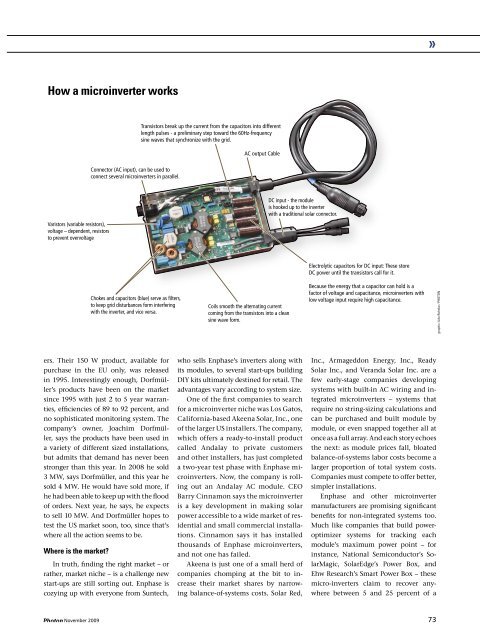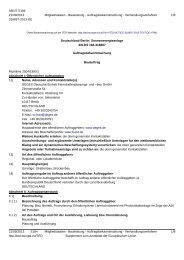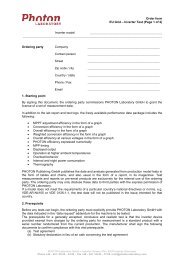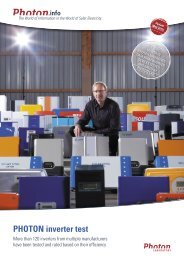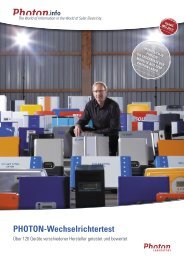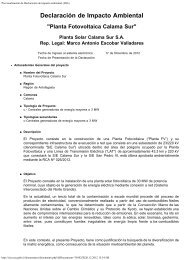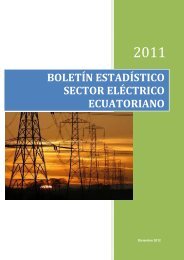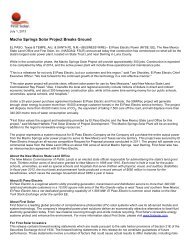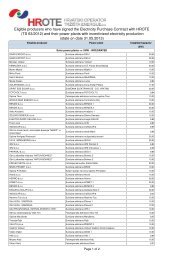INTRODUCTORY SPECIAL INTRODUCTORY ... - PHOTON Info
INTRODUCTORY SPECIAL INTRODUCTORY ... - PHOTON Info
INTRODUCTORY SPECIAL INTRODUCTORY ... - PHOTON Info
You also want an ePaper? Increase the reach of your titles
YUMPU automatically turns print PDFs into web optimized ePapers that Google loves.
How a microinverter works<br />
Varistors (variable resistors),<br />
voltage – dependent, resistors<br />
to prevent overvoltage<br />
Connector (AC input), can be used to<br />
connect several microinverters in parallel.<br />
Chokes and capacitors (blue) serve as filters,<br />
to keep grid disturbances form interfering<br />
with the inverter, and vice versa.<br />
ers. Their 150 W product, available for<br />
purchase in the EU only, was released<br />
in 1995. Interestingly enough, Dorfmüller’s<br />
products have been on the market<br />
since 1995 with just 2 to 5 year warranties,<br />
effi ciencies of 89 to 92 percent, and<br />
no sophisticated monitoring system. The<br />
company’s owner, Joachim Dorfmüller,<br />
says the products have been used in<br />
a variety of different sized installations,<br />
but admits that demand has never been<br />
stronger than this year. In 2008 he sold<br />
3 MW, says Dorfmüller, and this year he<br />
sold 4 MW. He would have sold more, if<br />
he had been able to keep up with the fl ood<br />
of orders. Next year, he says, he expects<br />
to sell 10 MW. And Dorfmüller hopes to<br />
test the US market soon, too, since that’s<br />
where all the action seems to be.<br />
Where is the market?<br />
In truth, fi nding the right market – or<br />
rather, market niche – is a challenge new<br />
start-ups are still sorting out. Enphase is<br />
cozying up with everyone from Suntech,<br />
Transistors break up the current from the capacitors into different<br />
length pulses - a preliminary step toward the 60Hz-frequency<br />
sine waves that synchronize with the grid.<br />
AC output Cable<br />
Coils smooth the alternating current<br />
coming from the transistors into a clean<br />
sine wave form.<br />
DC input - the module<br />
is hooked up to the inverter<br />
with a traditional solar connector.<br />
who sells Enphase’s inverters along with<br />
its modules, to several start-ups building<br />
DIY kits ultimately destined for retail. The<br />
advantages vary according to system size.<br />
One of the fi rst companies to search<br />
for a microinverter niche was Los Gatos,<br />
California-based Akeena Solar, Inc., one<br />
of the larger US installers. The company,<br />
which offers a ready-to-install product<br />
called Andalay to private customers<br />
and other installers, has just completed<br />
a two-year test phase with Enphase microinverters.<br />
Now, the company is rolling<br />
out an Andalay AC module. CEO<br />
Barry Cinnamon says the microinverter<br />
is a key development in making solar<br />
power accessible to a wide market of residential<br />
and small commercial installations.<br />
Cinnamon says it has installed<br />
thousands of Enphase microinverters,<br />
and not one has failed.<br />
Akeena is just one of a small herd of<br />
companies chomping at the bit to increase<br />
their market shares by narrowing<br />
balance-of-systems costs. Solar Red,<br />
Electrolytic capacitors for DC input: These store<br />
DC power until the transistors call for it.<br />
Because the energy that a capacitor can hold is a<br />
factor of voltage and capacitance, microinverters with<br />
low voltage input require high capacitance.<br />
November 2009 73<br />
»<br />
Inc., Armageddon Energy, Inc., Ready<br />
Solar Inc., and Veranda Solar Inc. are a<br />
few early-stage companies developing<br />
systems with built-in AC wiring and integrated<br />
microinverters – systems that<br />
require no string-sizing calculations and<br />
can be purchased and built module by<br />
module, or even snapped together all at<br />
once as a full array. And each story echoes<br />
the next: as module prices fall, bloated<br />
balance-of-systems labor costs become a<br />
larger proportion of total system costs.<br />
Companies must compete to offer better,<br />
simpler installations.<br />
Enphase and other microinverter<br />
manufacturers are promising signifi cant<br />
benefi ts for non-integrated systems too.<br />
Much like companies that build poweroptimizer<br />
systems for tracking each<br />
module’s maximum power point – for<br />
instance, National Semiconductor’s SolarMagic,<br />
SolarEdge’s Power Box, and<br />
Ehw Research’s Smart Power Box – these<br />
micro-inverters claim to recover anywhere<br />
between 5 and 25 percent of a<br />
graphic: Udo Rohnke / <strong>PHOTON</strong>


